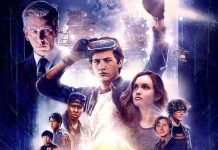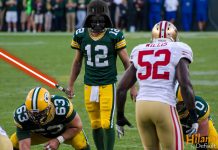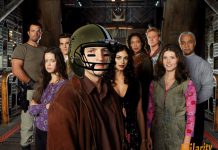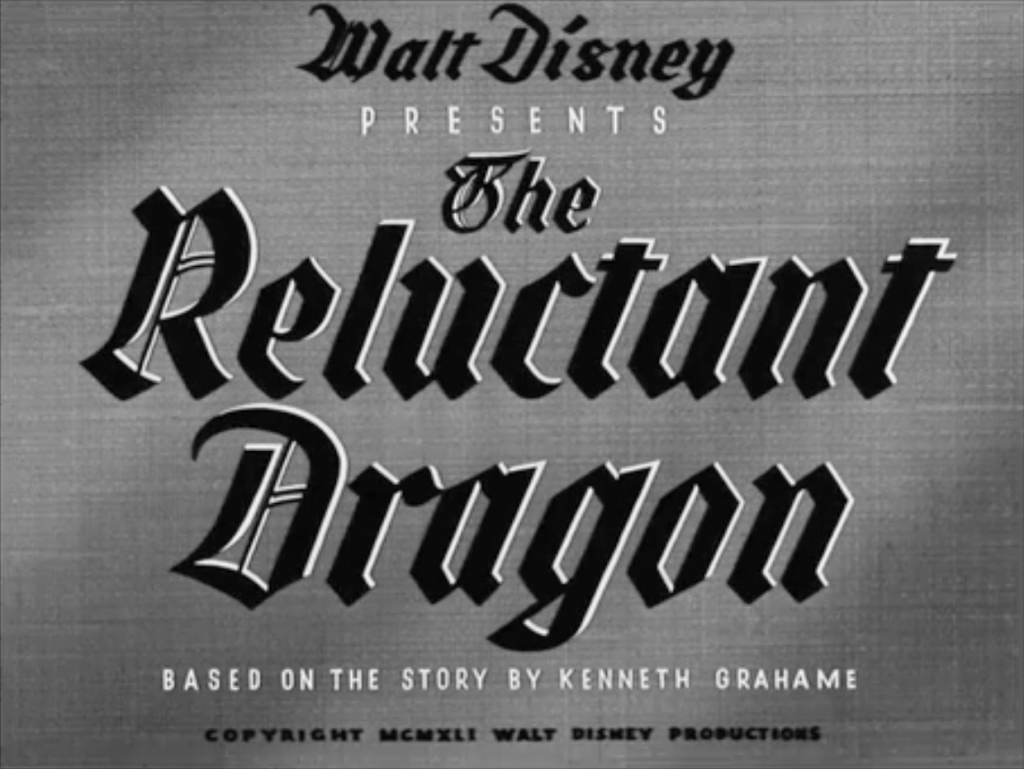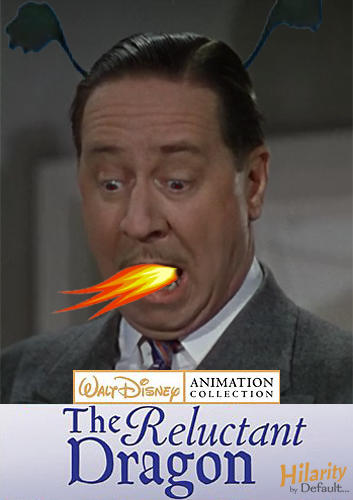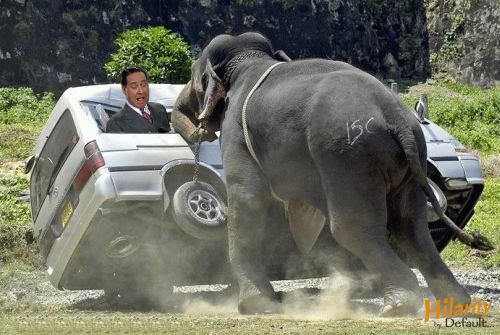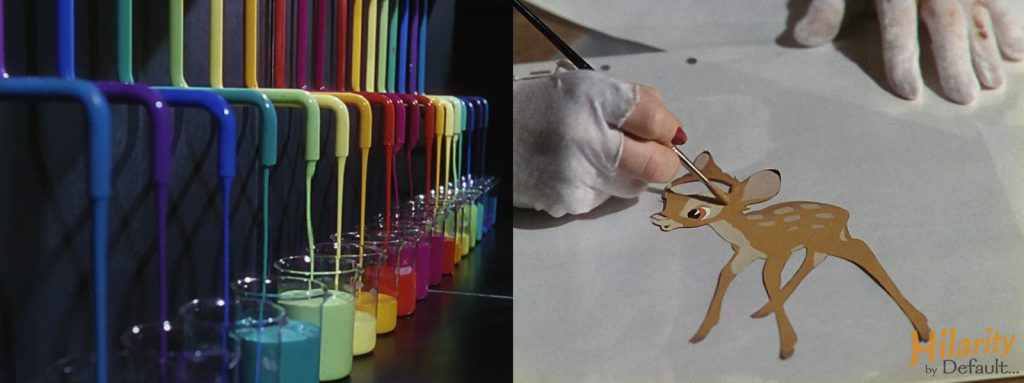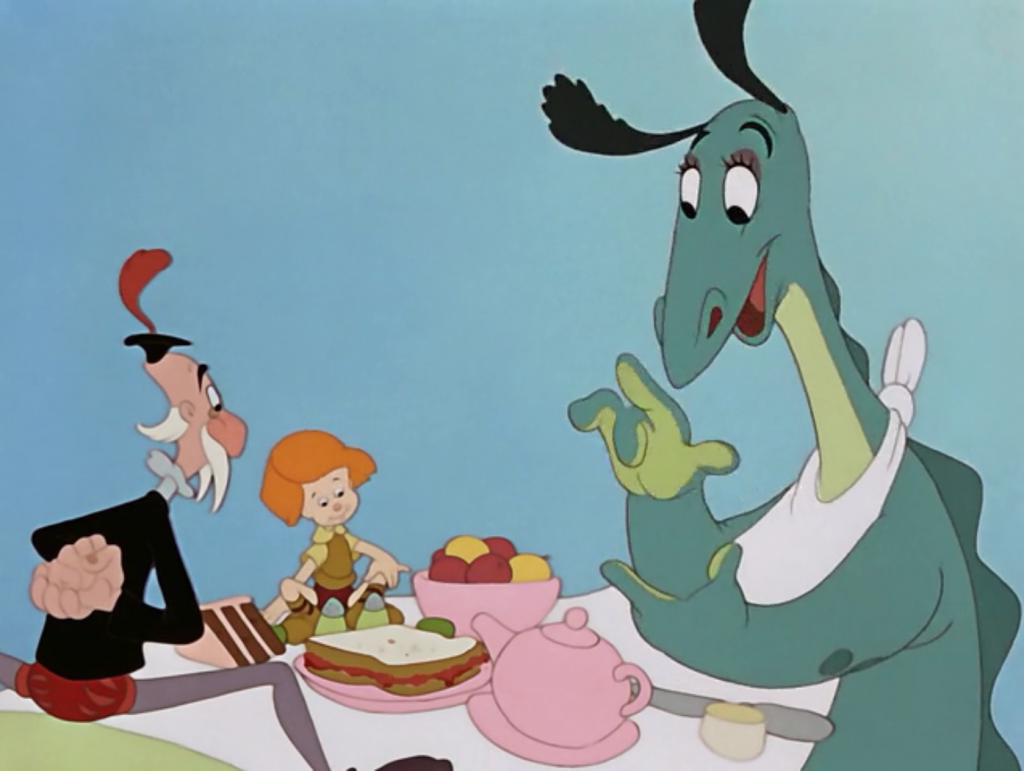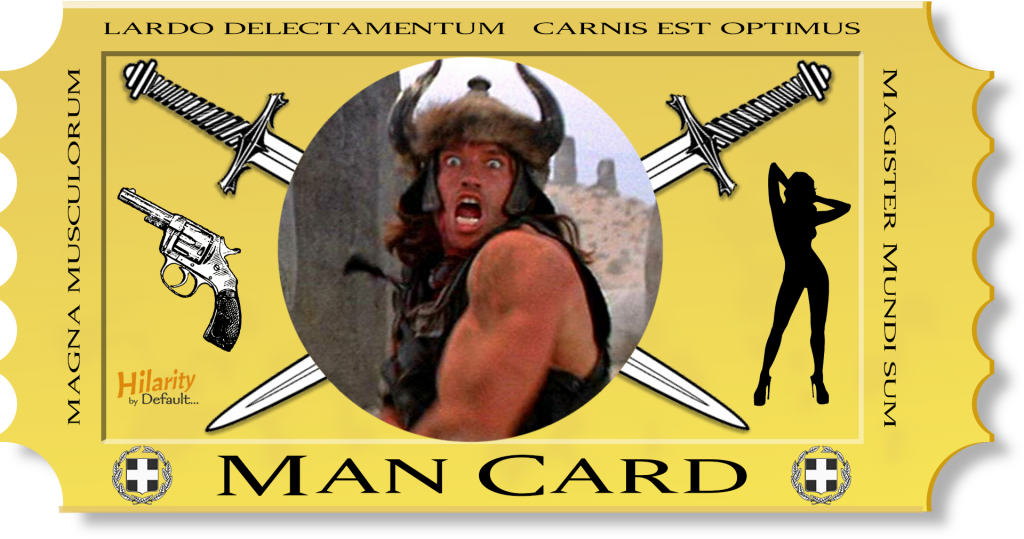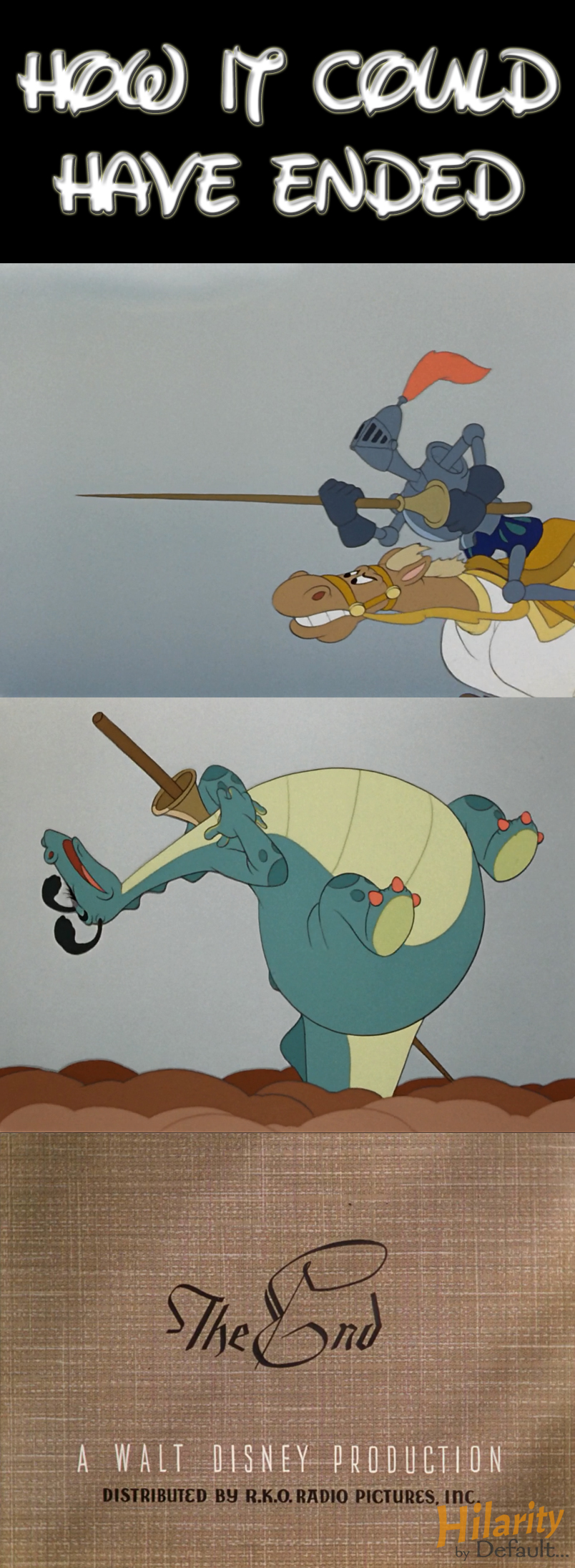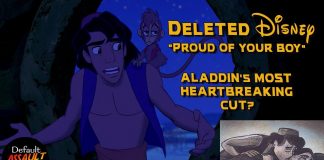If losing the European market due to World War II was bad enough for the Walt Disney Studios, worse was yet to come. In 1941, there was an animator’s strike led by Herbert Sorrell, head of the Screen Cartoonist Guild. The strike not only destroyed Walt’s faith in his animators, but also shattered the public’s perception of Disney. So what better time than to release a film that would depict the Studios as one big, happy-go-lucky family?
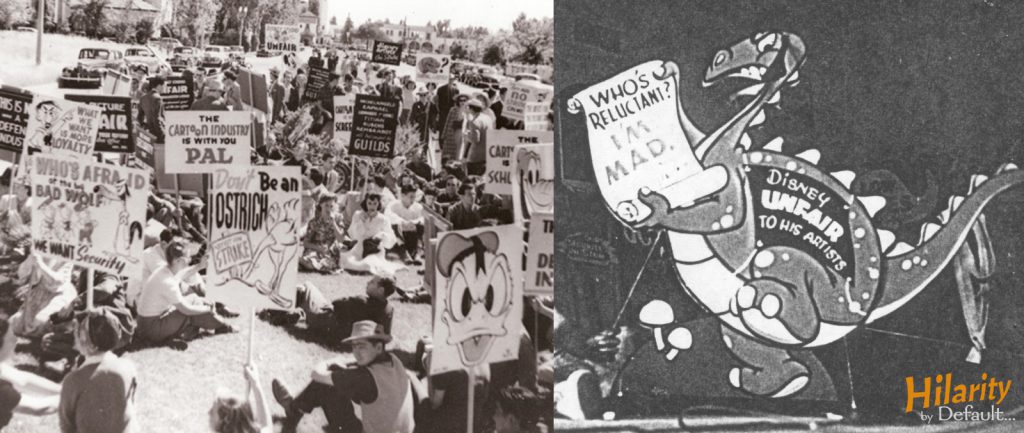
And how did Walt achieve this? By hiring actors to play most of the animators. There is almost as much fantasy in The Reluctant Dragon as there is in Pinocchio. Furthermore, the film just doesn’t have any direction. Does it want to be a documentary, a whimsical studio tour, or a collection of animated shorts? It tries to be all three and it falls short spectacularly. It may as well have been called The Reluctant Movie. Then again, to be fair, the opening titles do come attached with a warning:
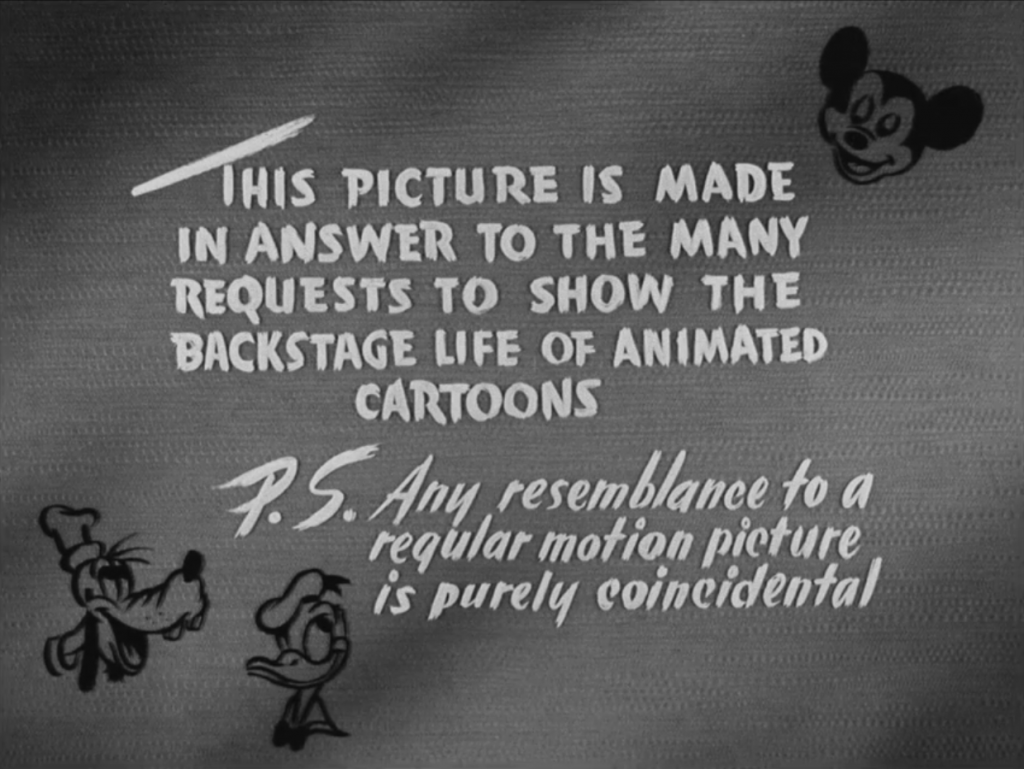
Walt Disney’s The Reluctant Dragon |
Despite the title, the animated “Reluctant Dragon” doesn’t make an appearance until the last twenty minutes of the film. The “plot,” or loose arrangement of bumbling segments, instead begins in a poolside setting with our “hero,” humorist Robert Benchley playing himself, and his aggravating wife that makes Cinderella’s stepmother an angelic honeybunch of love by comparison. Okay, that may be an exaggeration but there is not a single positive thing that can be said of the character. She employs every cliche of the older, embittered wife that you get the feeling that Benchley would rather shoot another target than his toy ducks.
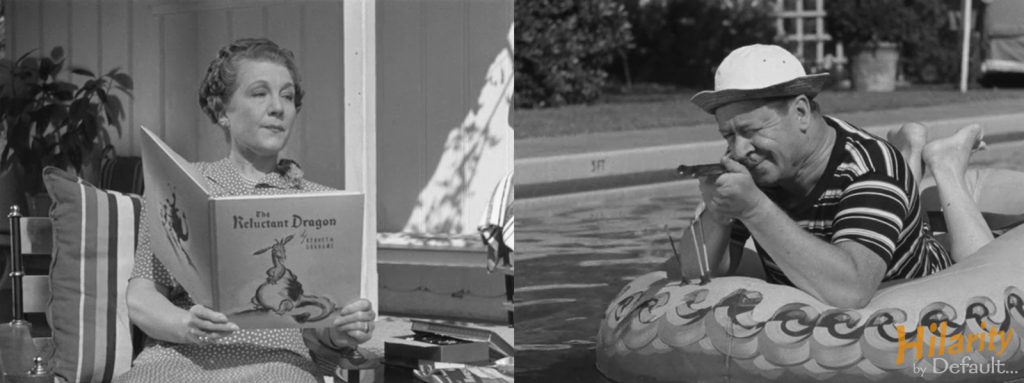
As she’s reading Kenneth Grahame’s “The Reluctant Dragon,” she suddenly implores, “We’ll sell this book to Walt Disney.” Just how is she going to do that exactly? It’s not like she wrote the darn book. And why is a middle-aged woman reading a children’s book to herself anyway? Regardless, Robert Benchley is so reluctant to do this that the title of the film may as well refer to him.
The next day, we see them driving up to the Disney Studios where Mrs. Benchley promptly abandons her husband and drives off so that she could go shopping. Really? The look of pain and anguish on Robert Benchley’s face is the most heartbreaking scene in the movie.
What follows are the reluctant Benchley’s aimless wanderings around the Disney Studios as he tries avoiding his appointment with Walt Disney himself. Hoping to see a naked model, he stumbles into an art class where a full-grown elephant is being modeled instead. He proceeds to make borderline racist remarks to a Chinese artist about her “coolie” elephant sketch and then instructs her as how to say “goodbye” in her own language.
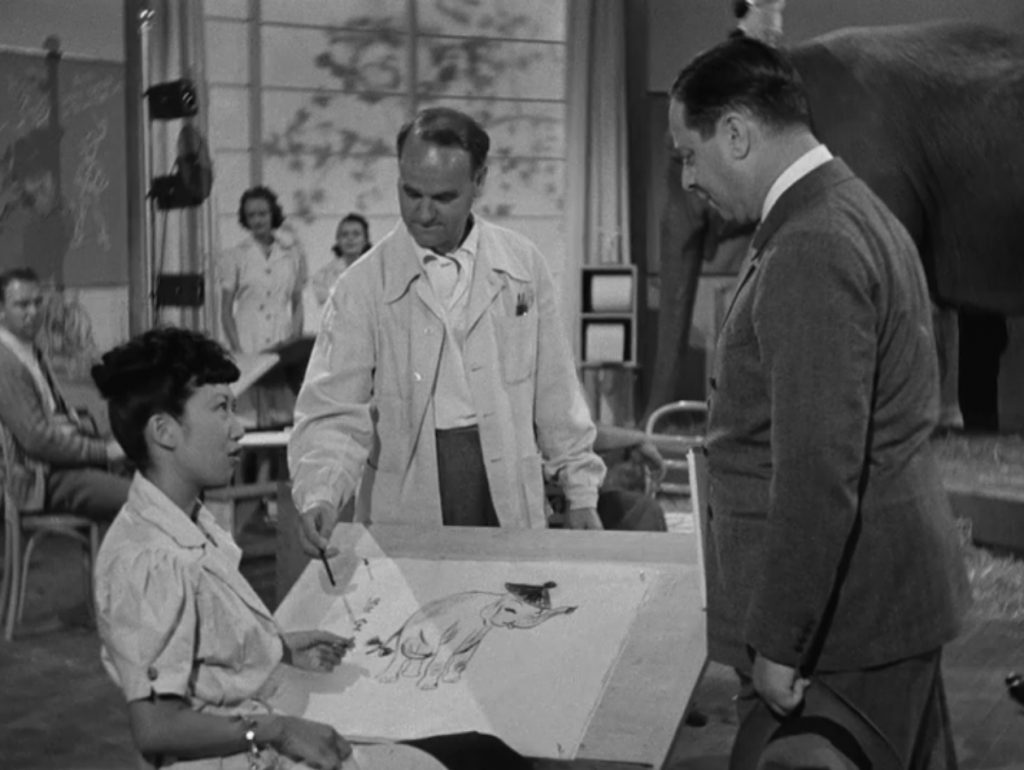
He continues to prattle on and makes the heinous mistake of mocking the poor elephant model. The elephant’s reactions prove that today, a mortal enemy has been made.
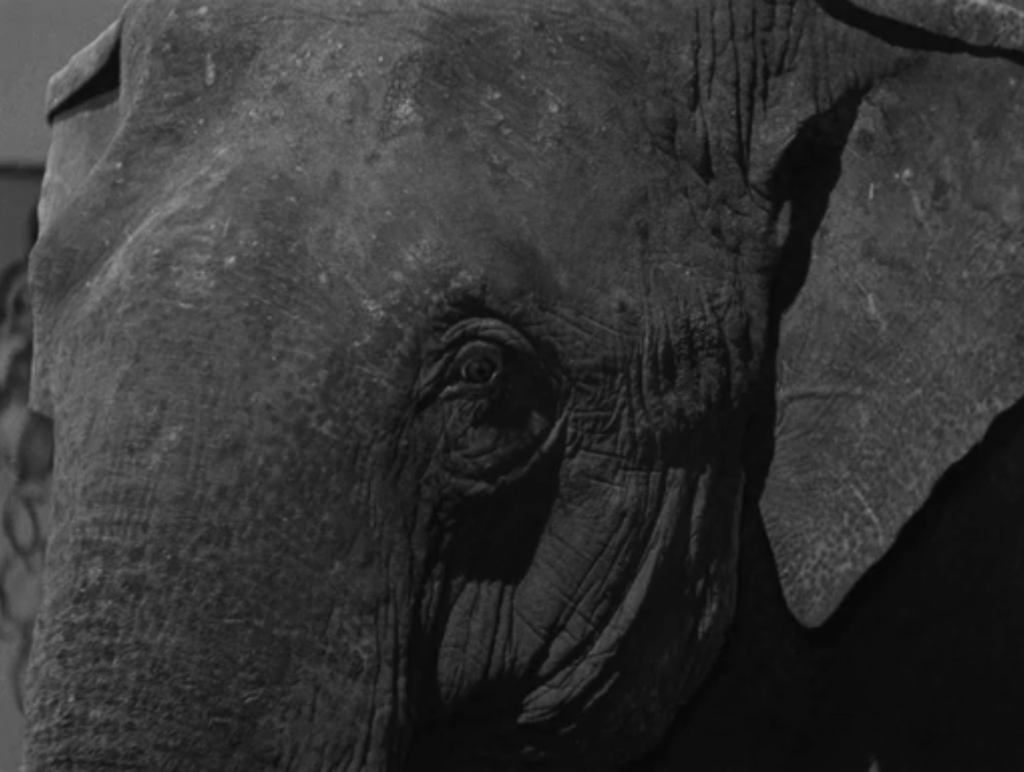
I’d like to think that years down the line, the elephant plotted and waited patiently for the perfect opportunity to enact his vengeance…
After bumbling into the music room and watching voice artists Clarence Nash and Florence Gill performing a duet as Donald Duck and Clara Cluck in an amusing scene, Benchley next visits the sound effects department where a short film featuring Casey Junior from Dumbo (which was released later that year) is being prepped.
This is actually one of the most interesting and effective scenes in the whole movie. It’s simply fascinating to watch the foley artists literally conduct a symphony of sound to accompany the Casey Junior short. From drums for the train tracks, to a sonovox to create Casey’s voice, to…
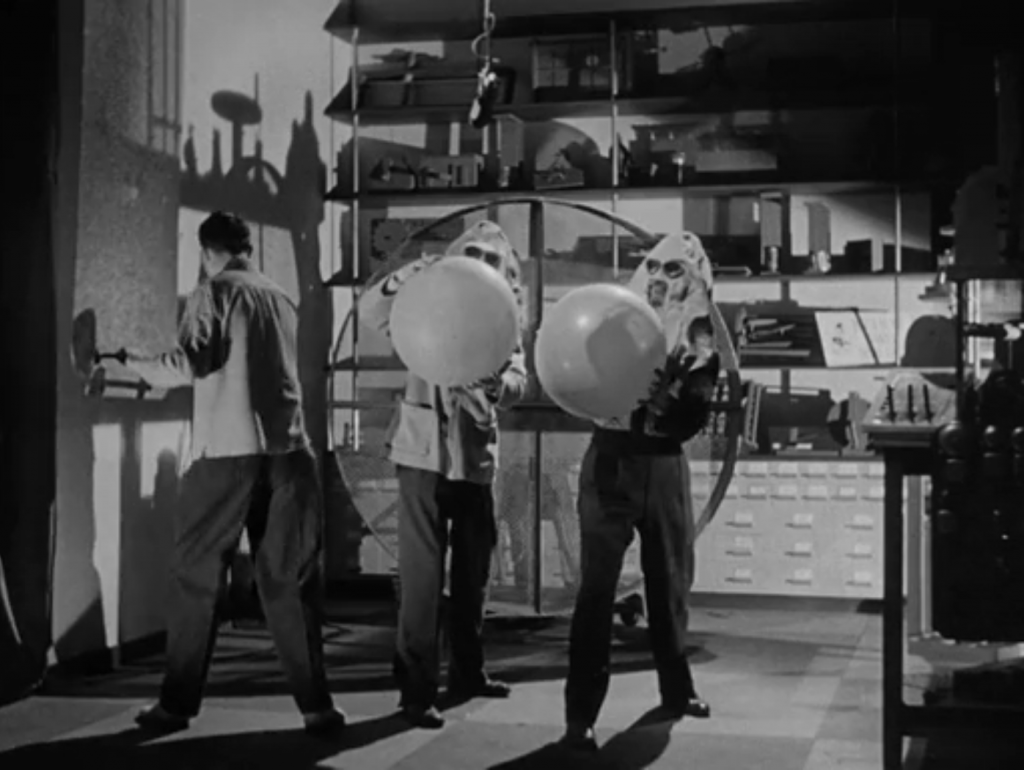
…two strange, masked men simulating a rain storm. It’s like the gimp from Pulp Fiction decided to hold a rave party. The only annoying part of the sequence is when Benchley exerts his ever impotent observation talent to anyone within earshot. While watching the cartoon, he sees some cows mooing and immediately states to one of the sound girls, “Cows.” What makes it more nonsensical is the look she gives him as if he just declared one of the most fascinating annotations in human history.
As Benchley ducks out of the sound effects room to escape the equally incompetent security detail searching for him, he enters the camera department where the film suddenly turns from black and white to color. Based on his reactions to suddenly seeing the world in color for the first time, it can be inferred that he has somehow inadvertently allowed color to enter the cosmos.
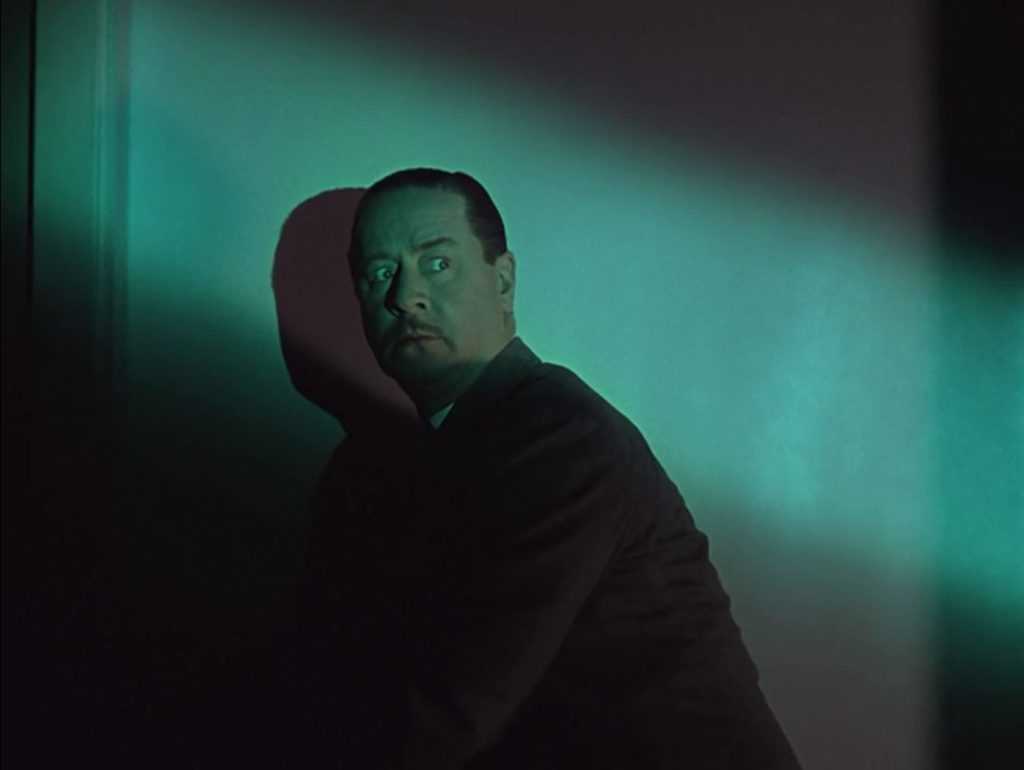
Oddly, he runs into the same actress, err, sound girl who decides to give him a tour as the married Benchley blatantly flirts with her.
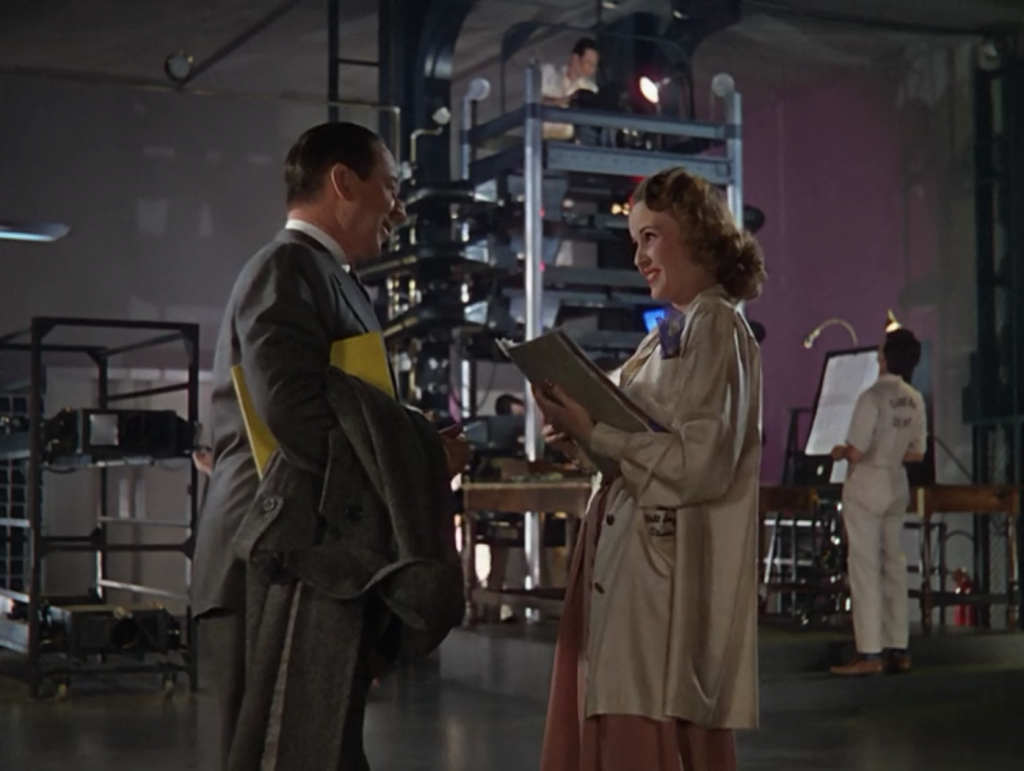
They have a brief look at the incredible multiplane camera (the system that allowed Disney to create a unique depth of field in their animated films) followed by a quick lesson in animation photography held by Donald Duck himself. It’s amazing that the animated Donald has more personality in his one-minute scene than any of the live-action actors in the film.
Next we have a short montage of the process of paint making in the ink and paint department. Without any hint of sarcasm, I can honestly say that this sequence is a highlight. Set to an instrumental of “Heigh-Ho” from Snow White and the Seven Dwarfs, we view the birth, chemical processing, and eventual end product in a rainbow of colors. It’s a potent display but, then again, what can you say about a film where a literal paint mixing montage is one of its most memorable parts?
In fact, much of the movie is scored to instrumentals from Snow White. Although lazy, it does give the studio tour an authentically “Disney” sound. Any other incidental music is quite bland and featureless.
Following a fleeting preview of Bambi (which would debut the following year), Benchley takes a tour of the model department where he promptly steals a topless zebra centaurette from Fantasia.
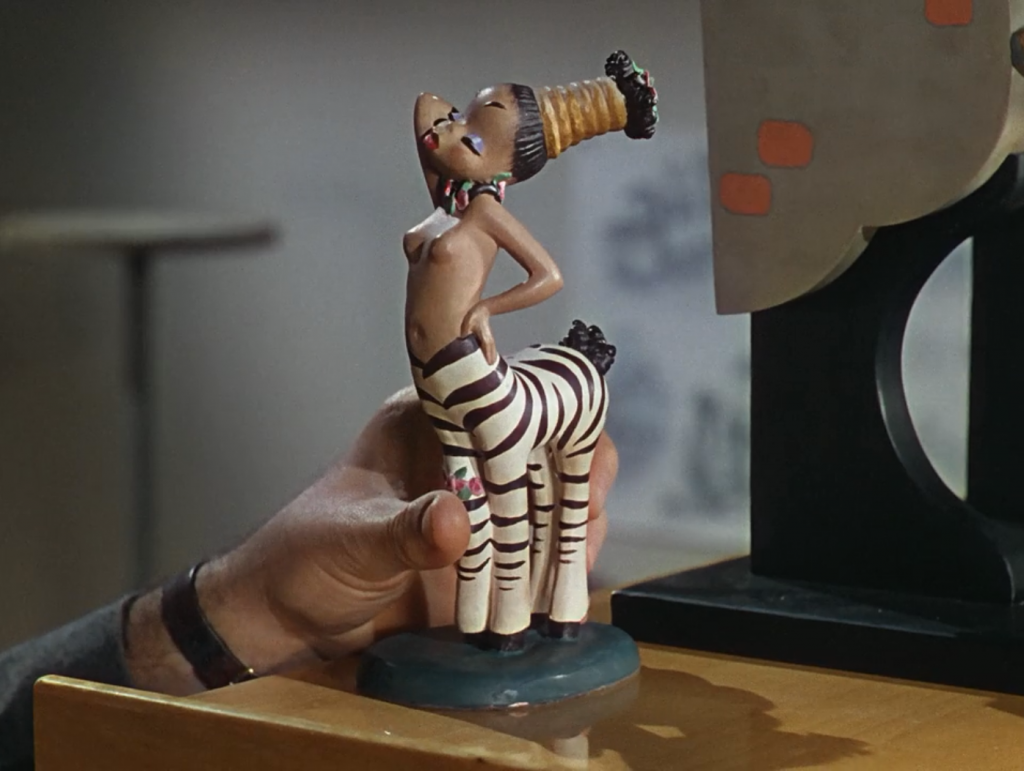
Seriously, this guy has now essentially become a security risk wandering around the Disney Studios, stealing racial stereotypes, making asinine observations, and searching for naked models. I’m almost yearning for a tour held by Fantasia‘s Deems Taylor instead – tedious narration and all!
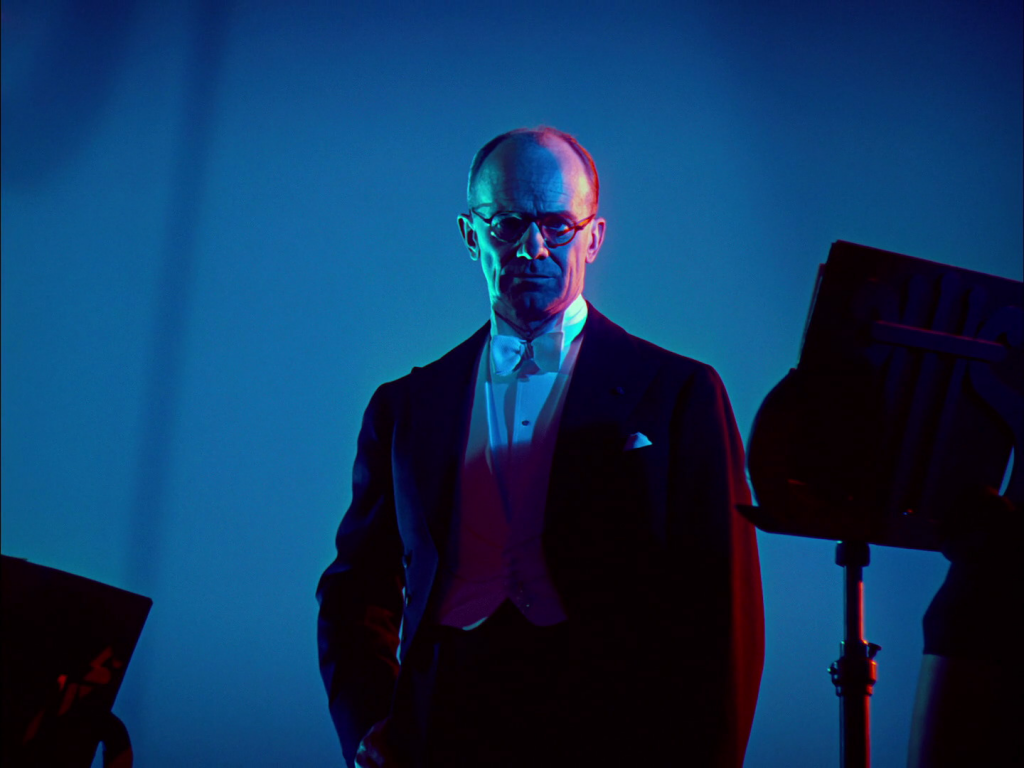
After continuing to elude Disney security, the reluctant Robert Benchley ditches the sound girl and resumes his aimless meanderings. At this point in The Reluctant Dragon, the studio “tour” takes a backseat and is instead used as a framing device for three short cartoons: “Baby Weems,” Goofy‘s “How to Ride a Horse,” and, of course, “The Reluctant Dragon.” In many ways, the film has much more in common with the “Package Features” (Disney movies comprised of multiple animated segments) that would dominate most of Disney’s output in the 1940’s.
“Baby Weems”
|
Benchley, upon seeing a nurse with a bottle, follows her into the storyboard department where he spots a few story artists going gaga over a baby in a graduation cap. After a compulsory “how cute is this baby” sequence, the artists corner Benchley for his opinion on their latest project – “Baby Weems.”
“Baby Weems” is the most effective of the final three animated segments. Told in a minimalist style through the animated storyboards, it is the chronicle of a baby who, upon his birth, is a downright genius. He reaches fame and fortune, fixing world problems and making scientific discoveries that even put Einstein to shame.
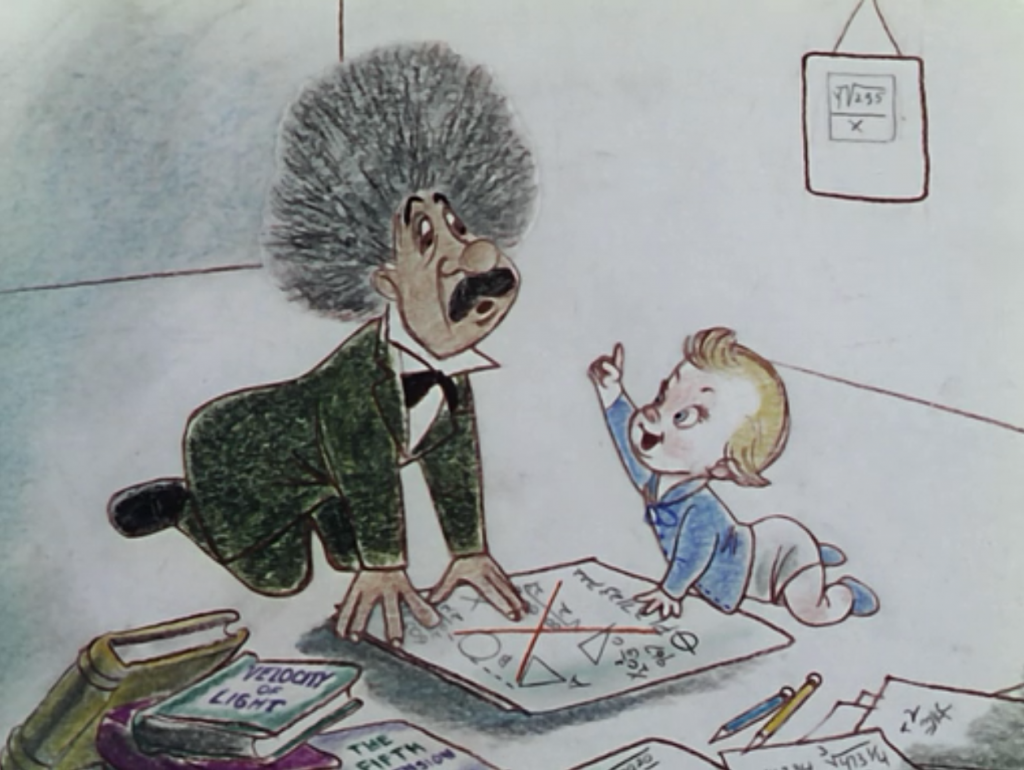
Tragically, his parents are sidelined and all they can do is pathetically support their offspring by listening to the radio (which they amusingly rock in a crib) or watching his parades perched on top of buildings. After nearly succumbing to a fatal fever, Weems recovers having lost his pansophical abilities. The world quickly denounces him save for two happy parents who finally have their baby back.
“Baby Weems” has many clever moments and social commentary such as the fleeting marketability of fame…
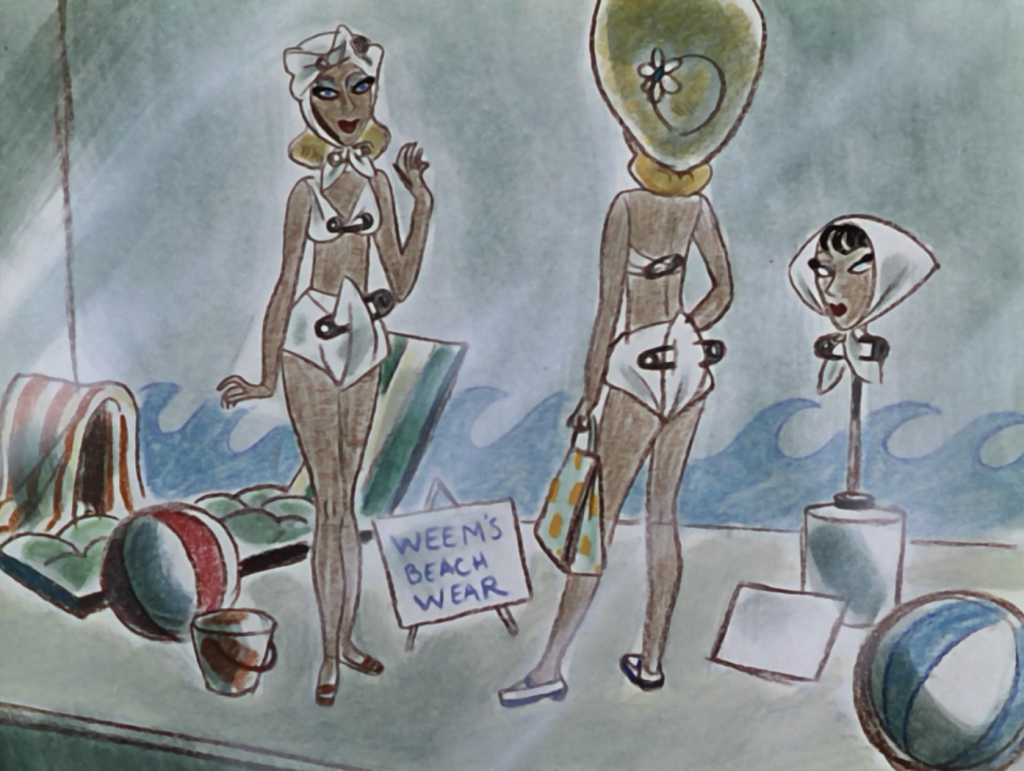
…or the temperamental worldwide furor the media can create. Many public figures and multinational representatives are parodied throughout the short, but it never becomes excessively offensive…
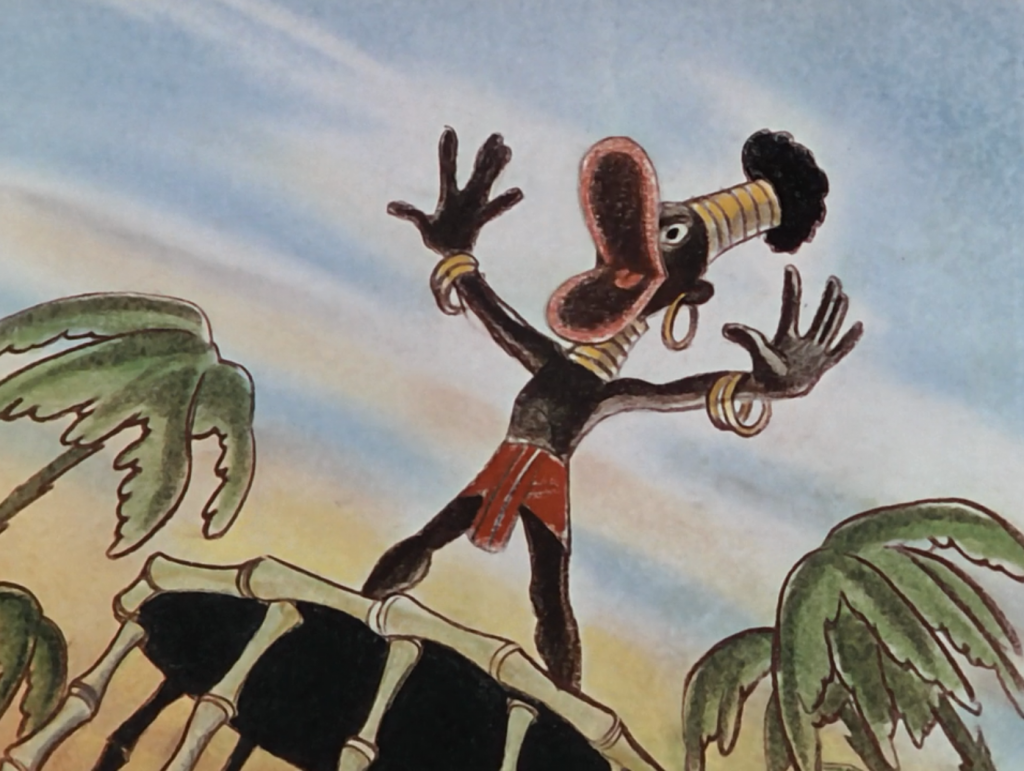
Regardless, “Baby Weems” is a sufficient representation of the storyboarding process and, unlike much of the rest of the film, it does generate short-lived moments of creativity and emotion.
“How to Ride a Horse”
|
Benchley next visits the animators’ rooms where he is just in time for a preview of the newest Goofy cartoon – “How to Ride a Horse.” Regarded as the first of Goofy’s “How To” series, it is appropriate that it debuted here with Robert Benchley who had already found success for his own “How To” shorts such as the Academy Award-winning “How to Sleep” (one wonders if this film was an unofficial sequel). “How to Ride a Horse,” however, is far from the strongest in this particular series. Apart from a few good gags and the animated dexterity of Goofy himself, it is one his blandest forays. It feels restrained and lacks the energetic bite that usually adorn many of Goofy’s cartoons (such as the amazing “Goofy’s Glider,” the first released “How To” short). Add to that an anticlimactic finale and lazy background animation (even in relation to other Disney shorts from the time) which sum this up as nothing more than a goofy time-filler.

In comparison, a similar concept was later presented in the “El Gaucho Goofy” segment from Saludos Amigos – albeit with an Argentinian twist. The animation, gags, story, and theming were far more successful in this latter attempt.
“The Reluctant Dragon”
|
By the time Robert Benchley meets Walt Disney in the studio projection room, the film had more or less become The Reluctant Drag On. His meeting with Walt feels forced and is notably lack of charm. As he greets him, Walt looks on incredulously as Benchley hands him all the items that he has collected throughout the day.

As it turns out, Walt has already produced his version of Kenneth Grahame’s book and, by sheer “coincidence,” that’s the film they are about to screen.
“The Reluctant Dragon” is faithful to Grahame’s story about a dragon who would rather have tea parties and recite verses than fight the gallant knight, Sir Giles (replacing the book’s St. George), who has been called upon by a nearby village to vanquish him. After a local boy introduces the two, it turns out that Giles also shares a love of poetry which allows them to bond. After a wacky mock fight, the townspeople finally accept the dragon as one of their own.
The work and animation in “The Reluctant Dragon” is simple, albeit without any appeal – just like the finished film as a whole. The characters are not empathetic and the dragon himself is too much of an effeminate, prissy caricature to be likable.
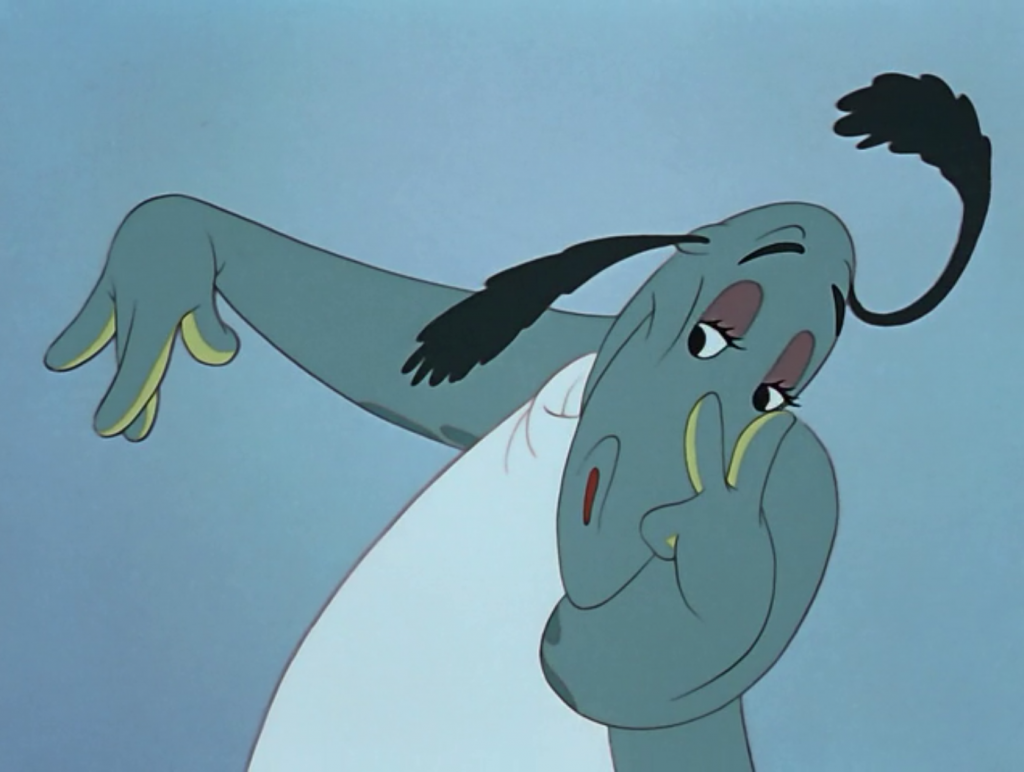
In short, “The Reluctant Dragon” is unremarkable but harmless enough on its own. As the denouement to the film, it’s disappointing to say the least. On a positive note, it is reassuring to know that Disney would eventually create the greatest (and prominently unreluctant) animated dragon of all time.
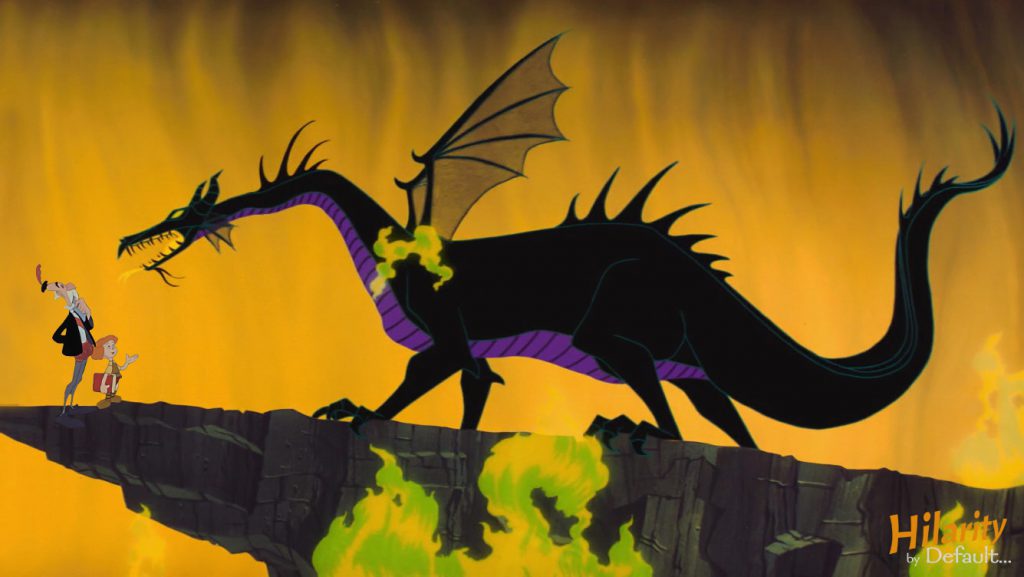
Final Thoughts |
What makes The Reluctant Dragon interesting is simple retrospect. It’s a fascinating time capsule of the Walt Disney Studios (despite the showmanship) and it is intriguing to catch a glimpse or allusion to future projects. As a film, however, it’s a jumbled mess. How effective is it to show the animation process, for instance, in such a muddled arrangement? If the intention was to demonstrate “the backstage life of animated cartoons” (as the title card says), why not show it in an orderly fashion? Why not start the film in the storyboard room, where all stories begin, before progressing to the art class, animator’s room, the ink & paint department, and so on. After all, the end result of finishing in the projection room with Walt Disney would have remained the same if done this way. Additionally, it would have spread out the animated sequences throughout the film rather than showing them all in succession halfway through.
Moreover, the only animated sequence that does work well is the Casey Junior short. It is the most relevant to the department being toured and it is the closest we get to actually seeing work being done on a genuine upcoming project (Dumbo). “Baby Weems” also gets a pass because of its adept presentation through storyboards. The other two shorts are perfunctory despite “The Reluctant Dragon” sharing the film’s title (its catalyst for the entire plot is preposterous after all). Heck, had the whole film been specifically about the making of “The Reluctant Dragon” from storyboard to screening, it could have been much more compelling.
As a historical curiosity and for Disney film lovers, The Reluctant Dragon is a tolerable diversion but this is a tour that is not worthy of its incredible subject matter. I would be reluctant to recommend it for any other reason.
Man-Card Retribution |

Man-Card Verdict: +1
Random Afterthoughts… |
After witnessing some of the strange expressions people make in the film, you wonder if there’s either something wrong with the air they’re pumping into these offices or if Robert Benchley accidentally wandered into a sanitarium that the delusional inmates have mistaken for the Disney Studios.

In hindsight, one interesting aspect about the movie is the chance to catch early versions of various Disney projects that had not yet been made. From drawings of Peter Pan and Dumbo in the art class to early renditions of characters from Lady and the Tramp (fourteen years before the film came out) in the model room.

At one point when Robert Benchley is touring the model room, he muses to himself that “everyone’s here, except Mickey Mouse.” A very insightful observation on his behalf for once. While you see animated versions of Donald and Goofy, Mickey doesn’t make an appearance as a character. Very odd, especially since this is a tour of the studio that, as Walt was fond of saying, “all started with a mouse.”
Some history: the now famous Mickey Ave/Dopey Drive sign seen in the film was originally built for the movie and was intended to be taken down afterward. It wasn’t and it still stands there to this day over 70 years later.
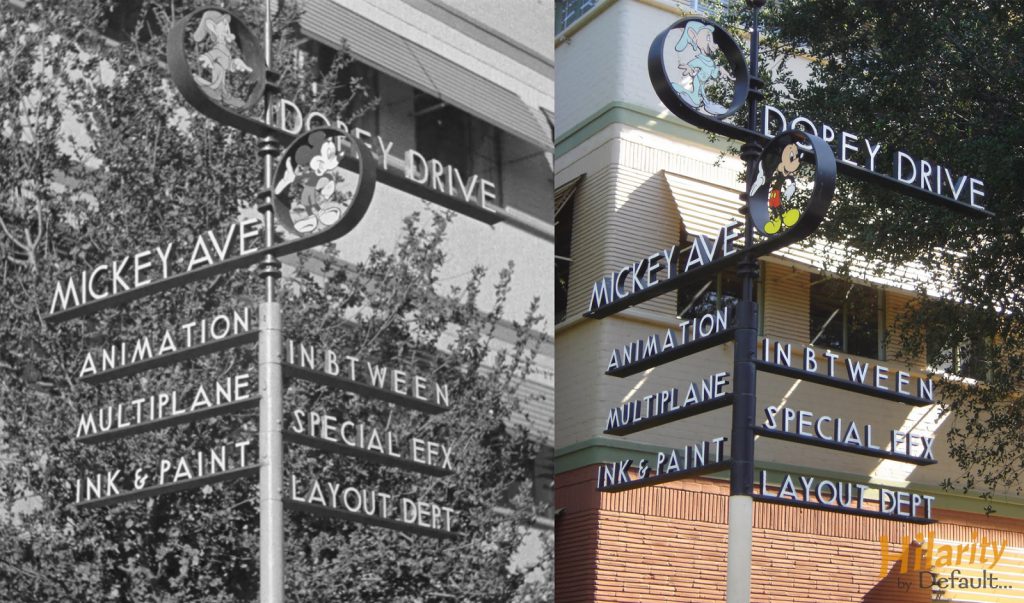
Join us next time when we take our first look at the Disney animated series that eventually inspired his animated features – the Silly Symphonies with their debut entry, “The Skeleton Dance.” For more Default Disney, click here.





